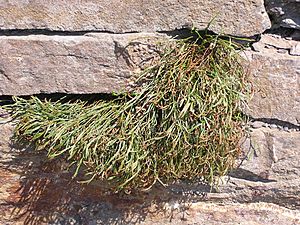Northern spleenwort facts for kids
Quick facts for kids Northern spleenwort |
|
|---|---|
 |
|
| Conservation status | |
| Scientific classification | |
| Genus: |
Asplenium
|
| Species: |
septentrionale
|
| Subspecies | |
|
|
| Synonyms | |
|
|
Asplenium septentrionale is a type of fern often called the northern spleenwort or forked spleenwort. This fern grows naturally in Europe, Asia, and western North America. You can usually find it growing on rocks. Its long, thin leaves make it easy to spot. There are three main types, or subspecies, of this fern. These types are different because of their chromosome numbers, which can be diploid (two sets), tetraploid (four sets), or a hybrid (mix) of the two.
Contents
What Northern Spleenwort Looks Like
Asplenium septentrionale is a small fern. It grows in thick groups that can look a bit like clumps of grass.
Its Leaves and Stems
The fern has long, dark stems. These stems hold up narrow, tough leaves. The tips of the leaves often look slightly forked, like a tiny two-pronged fork. All the leaves look the same, whether they are used for reproduction or not.
The plant grows from a rhizome (an underground stem) that is about 1 millimetre wide. This rhizome is covered with small, dark scales. These scales are thin and pointed, about 2 to 4 millimetres long. The stalks of the leaves, called stipes, are reddish-brown at the bottom. They turn green closer to the leaf blade. These stalks are usually 2 to 13 centimetres long. They are often 2 to 5 times longer than the leaf blade itself.
The leaf blades are narrow, from 0.5 to 4 centimetres long and 0.1 to 0.4 centimetres wide. They are pointed at both ends and feel a bit like leather. Often, the blade divides into two (sometimes four) smaller parts called pinnae near the tip. These pinnae point sharply towards the blade's tip, making the leaf look forked. They also have pointed tips and a few jagged teeth. The main stem of the leaf, called the rachis, is green and shiny. The leaves and rachis are smooth, without hairs or scales.
How it Reproduces
On fertile leaves, you can see small, brown lines called sori. These sori are found on the underside of the pinnae, usually two or more on each. They are covered by a thin, light-brown cover called an indusium. Each sorus contains many tiny spore cases. Each spore case holds 64 spores. Most of these ferns have 144 chromosomes. This means they are tetraploid, having four sets of chromosomes.
Each plant has many leaves. They grow in thick clumps from the rhizome. Sometimes they form mats on flat rocks. It's easy to tell A. septentrionale apart from other ferns. Its narrow, often forked leaves are unique. The sori on its fertile leaves also help tell it apart from grasses.
About Its Name
This fern was first named Acrostichum septentrionale by Carl Linnaeus in 1753. Later, in 1796, Georg Franz Hoffmann moved it to the genus Asplenium. The name septentrionale means "northern."
Different Types of Northern Spleenwort
In 1980, scientists found some A. septentrionale ferns with only two sets of chromosomes (called diploid). This led to dividing the species into two main types, or subspecies:
- A. septentrionale subsp. septentrionale: This is the tetraploid type with four sets of chromosomes. It is found all over the northern parts of the world.
- A. septentrionale subsp. caucasicum: This is the diploid type with two sets of chromosomes. It is mostly found in southwest Asia.
Scientists believe the tetraploid type grew from the diploid type. The two subspecies look very similar. But A. septentrionale subsp. caucasicum has narrower leaves (up to 0.12 centimetres wide). Its spores are also smaller, about 34 micrometres across.
Sometimes, different types of ferns can mix their genes. This fern can create hybrids with other spleenworts. For example, it can mix with maidenhair spleenwort (A. trichomanes) to form A. × alternifolium. It can also mix with wall-rue (A. ruta-muraria).
Where it Lives
Asplenium septentrionale subsp. septentrionale is found in many places. It grows across Europe and Asia, from the Macaronesian Islands to China and Taiwan. It also lives in North America. In the United States, it is mostly found in the Rocky Mountains and the Sierra Nevada. You can also find it in places like western Texas and parts of West Virginia.
Asplenium septentrionale subsp. caucasicum has been found in countries like Georgia, Iran, Pakistan, and Turkey.
What Kind of Places it Likes
This fern likes to grow on rocks. You can find it in cracks in rocks, around big boulders, and on cliffs. It can grow on different types of rocks, including granitic rocks and limestone. In the United States, it grows at high places, from about 700 to 2900 meters (2300 to 9500 feet) above sea level.
Growing Northern Spleenwort
Asplenium septentrionale is a tough plant. It can survive cold winters down to USDA Zone 4. This means it can handle temperatures as low as -30 to -34 degrees Celsius (-20 to -30 degrees Fahrenheit).
It grows best in partial sun or medium light. The soil should be moist but also drain well. It doesn't need a lot of watering. This fern is sensitive to having its roots moved. Because of this, it can be hard to plant in a new spot. Nurseries rarely sell it.
See also
 In Spanish: Asplenium septentrionale para niños
In Spanish: Asplenium septentrionale para niños



